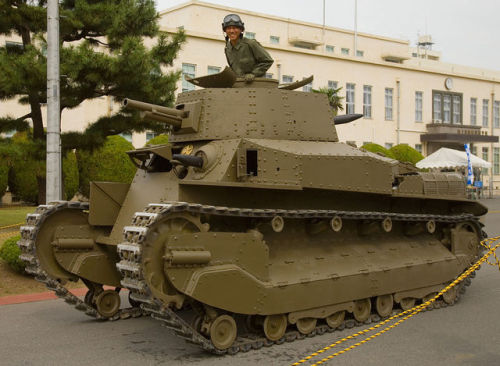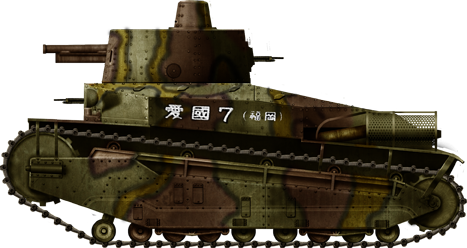Tanks of the Rising Sun Part I — Beginnings; The Type 89In case you missed: IntroIn the early
Tanks of the Rising Sun Part I — Beginnings; The Type 89In case you missed: IntroIn the early 1920’s Japan began to purchase a number of tanks from other countries, most notably the French Renault FT. Initial Japanese experience with tanks whetted their appetite for more, and in the 1925 it was decided that Japan had to produce it’s own tank designs. The first tank design was to be a medium tank specifically designed for infantry support and was to serve as the Imperial Japanese Army’s primary battle tank. The Army Technical Bureau set the following specifications for the new design including:1. To be able to attack “strong field positions” but also have mobility.2. Equip the tank with a 57 mm main gun and front and rear mounted machine guns for “effective” fire power.3. Armor plating to withstand at least a 57 mm anti-tank gun.4. Capable of trench crossing of 2.50 m, and climbing capabilities of 43 degrees.5. A complement of 5 crew members.6. A width and height which allows railway transportation.7. A tank able to be operated and driven by one driver.8. An operation range of at least 10 hours.In February, 1927 Japanese tank designers introduced the Type 87 Chi-I, which was completely designed and built from the tracks up from scratch. The IJA was not impressed with the results. A massive steel beast of a tank, the Type 87 weighed 20 tons, which was incredibly large at the time. Due to it’s size the Type 87 lacked the mobility to meet many of the conditions set by the Army Technical Bureau. It’s heavy weight over-taxed it’s 140 hp gasoline engine and put too much torque stress on the transmission, resulting in break downs and extremely poor reliability. The IJA rejected the Type 87, forcing Japanese tank designers back to the drawing board.Japanese Type 87 Experimental PrototypeRather than attempt to build another tank from scratch, the Japanese turned to Europe for design inspiration, after all it would be better to simply do what they had been doing since some European nations had tank experience going back to World War I. After the failure of the Type 87, Japan purchased a number of Vickers Medium C tanks to be used for design inspiration. In April of 1928 the Type 89 I-Go-Ko was introduced, and would become Japan’s first mass produced tank. The Type 89 I-Go-Ko was significantly lighter than the earlier Type 87, weighing around 12 tons. It featured a Type 90 57mm gun that was designed to fire high explosive shells at a relatively low velocity (around 380 m/s). The purpose of this was to be able to lob high explosive shells in a large ballistic arc to bombard enemy positions. The use of the Type 90 gun fit the Japanese tank doctrine of infantry support well, however while it was excellent for destroying enemy machine gun nests, rifle pits, pill boxes, and other light infantry fortifications, it proved inadequate against other armored vehicles. The gun itself featured -15 degrees of depression and 10 degrees of elevation. In addition to the main gun, the Type 89 featured two 6.5 mm light machine guns, one facing forwards located to the right of the driver, and one facing to the rear. In a pinch, the turret could be turned 180 degrees, thus making the machine gun the tank’s main gun in the case that more machine gun support was needed. The Japanese would never really catch on to the idea of a co-axial machine gun. The Type 89’s armor consisted of a 17mm front glacis, 17mm turret, a 25mm gun mantlet, 17mm side armor, and 6mm rear armor. The armor itself was a combination of riveted and welded steel. The Type 89 was powered by a 100 horsepower gasoline engine which gave it a top speed of 15.5 kph. Crew consisted of four; a commander who also acted as gunner, a loader, driver, and machine gunner. The Type 89 I-Go-Ko lacked radios except for a few command models, instead communication was done by flag signals.In 1932 an upgraded model entered into service called the Type 89B I-Go-Otsu. The main upgrade with the I-Go-Otsu was the replacement of the gasoline engine with a 6 cylinder diesel engine. The new diesel engine was more economical since diesel is easier to refine from oil, and of course throughout the 1930’s and World War II Japan would suffer severe oil shortages. The new engine also added 20 extra horsepower giving the tank better mobility (25kph) and it was less prone to catching fire. With the I-Go-Otsu the Type 89 would go down in history as the first mass produced diesel engine tank. Other modifications included a front glacis that was sloped at a steeper angle increasing the effective thickness of the armor. Driver and machine gunner swapped places. A unique assymetrical turret was installed,rear armor effectiveness when the machine gun was brought to bear. The use of such a turret would become common with future designs . Finally, by the late 1930’s most Japanese tanks began to be installed with radios.The Type 89 first saw combat against the Chinese at the Battle of Shanghai in 1932. While in retrospect the tank’s light armor, slow speed, and low velocity gun might seem wanting, at the time it was a design that was competitive with most other European tanks. In combat against the Chinese it performed extremely well. With the Chinese Army lacking in anti-tank weaponry and only fielding a very limited number of foreign light tanks, the Type 89 had little competition and thus was the unquestioned master of armored warfare in the Far East. However by the mid 1930’s the Type 89 was beginning to show it’s age. In 1935 China began purchasing anti-tank rifles from the West which could pierce the Type 89’s armor. The vulnerabilities of the Type 89 were especially laid bare with the Battle of Khalkhin Gol in 1939, part of Japan’s invasion of Mongolia. In the battle Japanese tanks as a whole did well, being able to overrun many Soviet positions until being halted by superior numbers. However the Soviets fielded anti tank guns and tanks of their own which could effectively knock out Japanese tanks. Of 73 Japanese tanks that took part in the battle, 13 were knocked out, and dozens needed extensive repairs. It was only the skill and combat experience of Japanese crews which prevented the defeat from becoming an all out disaster for Japanese tank forces. However, the Japanese never experienced significant tank losses before, and the battle was a shock for Japanese tankers and tank commanders. Moreover it was a shock for the IJA, as they had never suffered defeat before.As early as 1935 Japan began designing a replacement for the Type 89 (which will be featured in a future post). Production ended in 1939, and they began being phased out of service in 1942. This did not mean that use of the Type 89 ended altogether. Many remained unofficially in service with various forces throughout the rest of World War II. It was not uncommon for Japanese forces to hang on to old, outdated equippment years, or even decades after they had been declared obsolete and officially withdrawn from service. Even after the war, the French were known to use some left over Type 89’s during the First Indochina War. Altogether 119 I-Go–Kos and 291 Otsu tanks were produced.This looks absurdly precarious -- source link
Tumblr Blog : peashooter85.tumblr.com
#history#tanks#tank warfare#armored warfare#wwii


